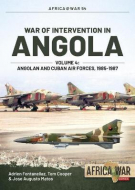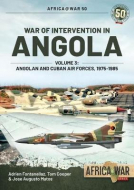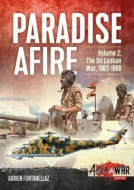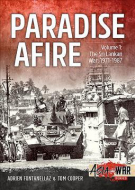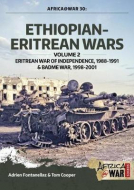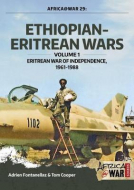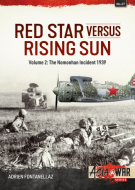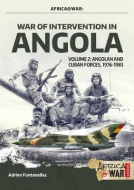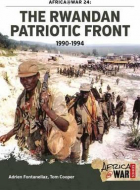
- Agriculture
- Architecture & Design
- Arts & Photography
- Biography
- Business
- Calendars and Diaries
- Childrens (All)
- Childrens (Illustrated)
- Childrens (Picture flats)
- Childrens (Te Reo)
- Classics
- Cooking, Food & Drink
- Craft & Hobbies
- Design (Art / Graphics)
- Design (Interiors)
- Education
- Fashion
- Fiction & Literature
- Fiction - Young Adult
- Gift Ideas
- Health & Wellbeing
- History
- Home & Garden
- Humour & Gift
- Instead of a Card Poems
- Military
- Music
- New Zealand
- NZ (History)
- NZ (Landscapes)
- NZ (Pictorial)
- Poetry
- Reference
- Religion & Faith
- Science & Nature
- Sport & Recreation
- Stationery
- Taschen : 40th Anniversary Edition
- Taschen : BA Basic Art
- Taschen : BU Bibliotheca Universalis
- Te Reo Māori
- Transport
- Travel
Adrien Fontanellaz (11)

|
Wars and Insurgencies of Uganda (Africa@War 23)
ISBN: 9781910294550 Authors: Tom Cooper, Adrien Fontanellaz Publisher: Helion & Company In 1971, Idi Amin Dada, a former officer of the King's African Rifles and commander of the Ugandan Army, seized power in a military coup in Uganda. Characterize... In 1971, Idi Amin Dada, a former officer of the King's African Rifles and commander of the Ugandan Army, seized power in a military coup in Uganda. Characterized by human rights abuses, political repression, ethnic persecution, extra judicial killings, nepotism, corruption and gross economic mismanagement, Amin's rule drove thousands into exile. Amin shifted the country's orientation in international relations from alliances with the West and Israel, to cooperation with the Soviet Union. With Tanzanian leader Julius Nyerere offering sanctuary to Uganda's ousted president, Milton Obote, Ugandan relations with Tanzania soon became strained too. Already in 1972, a group of Tanzania-based exiles attempted, unsuccessfully, to invade Uganda and remove Amin. By late 1978, following another attempted coup against him, Amin deployed his troops against the mutineers, some of whom fled across the Tanzanian border. The rebellion against him thus spilled over into Tanzania, against whom Uganda then declared a state of war. Opening with an overview of the ascent of crucial military and political figures, and the buildup of the Tanzanian and Ugandan militaries during the 1960s and 1970s, this volume provides an in-depth study of the related political and military events, but foremost of military operations during the Kagera War - also known as 'A Just War' - fought between Tanzania and Uganda in 1978-1979. It further traces the almost continuous armed conflict in Uganda of 1981-1994, which became renowned for emergence of several insurgent movements notorious for incredible violence against civilian population, some of which remain active in central Africa to this day. This book is illustrated with an extensive selection of photographs, color profiles, and maps, describing the equipment, markings, and tactics of the involved military forces. Bind: paperback Pages: 72 Dimensions: 210 x 300 mm Publication Date: 20-01-2016 |
$49.99 |
|
War of Intervention in Angola: Volume 4 (Africa@War 54)
ISBN: 9781914059254 Authors: Adrien Fontanellaz, Tom Cooper, Jose Matos Publisher: Helion & Company War of Intervention in Angola, Volume 4 continues the coverage of the operational history of the Angolan Air Force and Air Defence Force (FAPA/DAA) as told by A... War of Intervention in Angola, Volume 4 continues the coverage of the operational history of the Angolan Air Force and Air Defence Force (FAPA/DAA) as told by Angolan and Cuban sources, in the period 1985-1988. Many accounts of this conflict - better known in the West as the 'Border War' or the 'Bush War', as named by its South African participants - consider the operations of the FAPA/DAA barely worth commentary. At most, they mention a few air combats involving Mirage F.1 interceptors of the South African Air Force (SAAF) in 1987 and 1988, and perhaps a little about the activity of the FAPA/DAA's MiG-23s. However, a closer study of Angolan and Cuban sources reveals an entirely different image of the air war over Angola in the 1980s: indeed, it reveals the extent to which the flow of the entire war was dictated by the availability - or the lack - of air power. These issues strongly influenced the planning and conduct of operations by the commanders of the Angolan and Cuban forces. Based on extensive research with the help of Angolan and Cuban sources, War of Intervention in Angola, Volume 4, traces the Angolan and Cuban application of air power between 1985-1988 - during which it came of age - and the capabilities, intentions, and the combat operations of the air forces. The volume is illustrated with 100 rarely seen photographs, half a dozen maps and 15 color profiles, and provides a unique source of reference on this subject. Bind: paperback Pages: 80 Dimensions: 210 x 297 mm Publication Date: 15-07-2021 |
$49.99 |
|
|
War of Intervention in Angola Volume 3 (Africa@War 50)
ISBN: 9781913118617 Authors: Adrien Fontanellaz, Jose Matos, Tom Cooper Publisher: Helion & Company War of Intervention in Angola, Volume 3 covers the air warfare during the II Angolan War - fought 1975-1992 - through narrating the emergence and operational hi... War of Intervention in Angola, Volume 3 covers the air warfare during the II Angolan War - fought 1975-1992 - through narrating the emergence and operational history of the Angolan Air Force and Air Defence Force (FAPA/DAA) as told by Angolan and Cuban sources. Most accounts of this conflict - better known in the West as the 'Border War' or the 'Bush War', as named by its South African participants - tend to find the operations by the FAPA/DAA barely worth mentioning. A handful of published histories mention two of its MiG-21s claimed as shot down by Dassault Mirage F.1 interceptors of the South African Air Force (SAAF) in 1981 and 1982, and at least something about the activities of its MiG-23 interceptors during the battles of the 1987-1988 period. Bind: paperback Pages: 72 Dimensions: 210 x 297 mm Publication Date: 23-11-2020 |
$49.99 |
|
|
Paradise Afire Volume 2 (Asia@War 8)
ISBN: 9781912866304 Author: Adrien Fontanellaz Publisher: Helion & Company Upon achieving independence from Great Britain in 1948, the stunningly beautiful island of Ceylon, re-named Sri Lanka in 1972, was expected to become a sort of ... Upon achieving independence from Great Britain in 1948, the stunningly beautiful island of Ceylon, re-named Sri Lanka in 1972, was expected to become a sort of 'South Asian Singapore'. However, stable political order and bright economic prospects proved insufficient to maintain peace. A host of unsolved ethnic conflicts and social inequalities conspired to erupt into an armed conflict in 1971. By 1987, the crisis heated up to the point where the government in New Delhi began exercising fierce pressure upon the Sri Lankan government and the Sri Lankan Tamil insurgents to arrive at a peace deal. In order to help maintain peace, the Indian Peace Keeping Force was deployed on the island. However, with a few weeks, the troops of the Indian Army found themselves involved in a bloody and protracted confrontation with the most powerful of Tamil insurgent movements - the Liberation Tamil Tigers of Elam (LTTE). The peacekeeping operation was thus quickly converted into a military intervention and a bloody quagmire. To make matters even more complex, southern Sir Lanka meanwhile became engulfed in an unprecedented wave of public violence, triggered by the second insurrection of Sinhalese ultra-leftist movement, the JVP. Calling upon extensive studies of the Sri Lankan War, with the help of first hand sources, official documentation and publications from all of the involved parties, this volume provides an in-depth and particularly detailed account of military operations between 1987 and 1990. It is illustrated by over 120 photographs, maps and 12 color profiles. Bind: paperback Pages: 72 Dimensions: 210 x 297 mm Publication Date: 04-09-2019 |
$49.99 |
|
|
Paradise Afire Volume 1 (Asia@War 6)
ISBN: 9781912390342 Author: Adrien Fontanellaz Publisher: Helion & Company When released into independence from Great Britain in 1948, the stunningly beautiful island of Ceylon, renamed Sri Lanka in 1972, was expected to become a sort ... When released into independence from Great Britain in 1948, the stunningly beautiful island of Ceylon, renamed Sri Lanka in 1972, was expected to become a sort of 'South Asian Singapore.' However, stable political order and bright economic prospects proved insufficient to maintain peace. A host of unsolved ethnic conflicts and social inequalities conspired to erupt into an armed conflict in 1971. When this broke out the entire Sri Lankan society was shocked to its core by a large-scale insurgency instigated by a Sinhalese Maoist group, JVP. Worse still, this was followed by the gradual buildup of several other Tamil groups in the north of the island. Following riots known as 'Black July' in 1983, Sri Lanka was ripped apart by a murderous war against Tamil insurgents, which caught the armed forces wrong-footed because of the government's reluctance to buildup its military to necessary levels. This came to a temporary stop in 1987 with the implementation of a peace arrangement virtually enforced by the government of India and a deployment of a large peacekeeping force of the Indian military. By that time, the notorious LTTE emerged as the most powerful Tamil insurgent movement and the principal opponent of the Sri Lankan armed forces. Eventually, the Indian military intervention proved to be only a temporary solution. The LTTE turned against the Indian military but suffered heavily in return. However, this provided some breathing space for the Sri Lankan military, which then launched a vicious and protracted counterinsurgency campaign against the JVP. The fighting thus went on. Relying on extensive studies of the Sri Lankan War with the help of firsthand sources, official documentation and publications from all of involved parties, this volume provides an in-depth and particularly detailed account of military operations during the first 16 years of this war. Bind: paperback Pages: 72 Dimensions: 210 x 297 mm Publication Date: 18-05-2018 |
$49.99 |
|
|
Ethiopian-Eritrean Wars Volume 2 (Africa@War 30)
ISBN: 9781912390304 Author: Adrien Fontanellaz Publisher: Helion & Company Ethiopia, a country of ancient origins in eastern Africa, remains a military powerhouse of that continent until our days. Nowadays involved in the war in neighb... Ethiopia, a country of ancient origins in eastern Africa, remains a military powerhouse of that continent until our days. Nowadays involved in the war in neighboring Somalia, Ethiopia was also involved in half a dozen of other armed conflicts over the last 60 years. Crucial between these was the Eritrean War of Independence. Fought 1961-1991, this was one of biggest armed conflicts on the African continent, especially if measured by numbers of involved combatants. It included a wide spectrum of operations, from 'classic' counterinsurgency (COIN) to conventional warfare in mountains - with the latter being one of the most complex and most demanding undertakings possible to conduct by a military force. Campaigns run during the Eritrean War of Independence often included large formations of relatively well-equipped forces, led by well-trained commanders, along well-thought-out plans, based on homegrown doctrine. The air power played a crucial - although not necessarily decisive - role in many of battles. Nevertheless, most of details about this conflict remain unknown in the wider public. Similarly, relatively few Western observers are aware of relations between the Eritrean liberation movements, and various dissident and insurgent movements inside Ethiopia - although the synergy of these eventually led the downfall of the so-called Derg government, in 1991. While the first volume in this mini-series spanned the history of wars between Ethiopia and Eritrea between 1961 and 1988, the second covers the period since. Correspondingly, it is providing coverage of military operations that led to the fall of the Derg government in Ethiopia of 1991, the period of Eritrean military buildup and a complete reorganization of the Ethiopian military in the 1990s, and concludes with the first detailed account of the so-called Badme War, fought between Ethiopia and Eritrea in period 1998-2001. Bind: paperback Pages: 80 Dimensions: 210 x 297 mm Publication Date: 31-07-2018 |
$49.99 |
|
|
Ethiopian-Eritrean Wars Volume 1 (Africa@War 29)
ISBN: 9781912390298 Author: Adrien Fontanellaz Publisher: Helion & Company Ethiopia, a country of ancient origins in eastern Africa, has remained a military powerhouse of that continent until the present day. Currently involved in the ... Ethiopia, a country of ancient origins in eastern Africa, has remained a military powerhouse of that continent until the present day. Currently involved in the war in neighboring Somalia, Ethiopia was also involved in half a dozen of other armed conflicts during the last 60 years. One of the most significant was the Eritrean War of Independence. Fought 1961-1991, this was one of the biggest armed conflicts on the African continent, especially if measured by numbers of combatants involved. It included a wide spectrum of operations, from 'classic' counter-insurgency (COIN) to conventional warfare in mountains - with the latter being one of the most complex and demanding undertakings possible to conduct by a military force. Campaigns run during the Eritrean War of Independence often included large formations of relatively well-equipped forces, led by well-trained commanders, utilizing complex plans based on homegrown doctrine. Airpower played a crucial - although not necessarily decisive - role in many of battles. Nevertheless, most of details about this conflict remain unknown to the wider public. Similarly, relatively few Western observers are aware of relations between the Eritrean liberation movements, and various dissident and insurgent movements inside Ethiopia - although the synergy of these eventually led the downfall of the so-called Derg government, in 1991. Reaching back to extensive studies of Ethiopian and Eritrean military history, this volume provides a detailed account of the first 25 years of this conflict: from the outbreak of armed insurgency in 1961 until the crucial battle of Afabet, in 1988. It is illustrated by over 100 contemporary photographs, maps and color profiles. Bind: paperback Dimensions: 210 x 297 mm Publication Date: 19-04-2018 |
$49.99 |
|
|
Red Star versus the Rising Sun Volume 2 (Asia@War 27)
ISBN: 9781911628668 Author: Adrien Fontanellaz Publisher: Helion & Company During the first half of the 20th century, the Empire of Japan fought a series of undeclared wars in the Far East against Tsarist Russia and the successor Sovie... During the first half of the 20th century, the Empire of Japan fought a series of undeclared wars in the Far East against Tsarist Russia and the successor Soviet Union. The first of these, fought in 1904-1905 over rival imperial ambitions in Manchuria and Korea, ended in a clear-cut Japanese victory. Following the Japanese occupation of Manchuria, in 1931, Japan turned its interest to nearby Soviet territories. The result was a series of border incidents, starting with the Battle of Lake Khasan in 1938, as described in the first volume of Red Star versus the Rising Sun. Maintaining that the border between the Japanese proxy state of Manchukuo and the Soviet-dominated Mongolian People’s Republic was the Khalkhyn Gol (or Khalkha River), the Japanese deployed some of the best units of their army to occupy and secure this area. Following a military build-up, a series of bitter clashes took place in mid-May and June 1939, after which the Japanese launched an all-out assault in July. Due to heavy casualties, the battle resulted in a stalemate. With tension also rising in Europe and concerned about the possibility of facing a two-front war, the Soviets reacted with a major counter-offensive in August 1939, and defeated the Japanese. While relatively little-known in the West, this short but bitter war – known as the Nomonhan Incident in Japan, or the Battle of Khalkhyn Gol in the Soviet Union – was a crucial overture to the subsequent Second World War. Having secured its border in the Far East, the Soviet Union was free to concentrate on war in Europe, whilst the Japanese turned their attention to South-East Asia and the Pacific. Although continuing to underestimate their opponents, the Japanese introduced a major reform of their army and after realising the massive material disparity vis-à-vis the USSR, Tokyo and joined the Axis with Nazi Germany and Italy. The second volume of Red Star versus the Rising Sun examines the land and air forces of the opposing forces in the Far East as they stood in 1939 and offers a detailed description of the conflict on and above the battlefields of Nomonhan. This volume is richly illustrated with period photographs, maps and original colour artworks of the soldiers, aircraft and armoured vehicles deployed in this conflict. Bind: paperback Pages: 80 Dimensions: 210 x 300 mm Publication Date: 15-01-2022 |
$49.99 |
|
|
War of Intervention In Angola Volume 2 (Africa@War 34)
ISBN: 9781911628651 Authors: Adrien Fontanellaz, Tom Cooper Publisher: Helion & Company As of mid-1976, the civil war in Angola was seemingly decided: supported by a large contingent of Cuban forces, the MPLA established itself in power in Luanda. ... As of mid-1976, the civil war in Angola was seemingly decided: supported by a large contingent of Cuban forces, the MPLA established itself in power in Luanda. Its native competitors, the US-French-Zaire-supported FNLA, and UNITA, supported by China and South Africa, were in tatters. The French and Zaire-supported FLEC - an armed movement for the independence of the oil-rich Cabinda enclave - was in disarray. The last few of their surviving units were either driven out of the country, or forced into hiding in isolated corners of northern and southeastern Angola. Nevertheless, the war went on. The MPLA's government failed to decisively defeat UNITA, in southern Angola, and then found itself facing a coup attempt from within in May 1977. Crushed in blood, this resulted in thousands being jailed and tortured: many more escaped abroad, where they reinforced the ranks of the battered opposition. The coup prompted the Soviets to attempt increasing their influence with the aim of establishing permanent military bases in the country. While all such overtures were turned down, Angolan operations along the border to what was then the South-West Africa (subsequently Namibia) in October 1980, combined with the increased activity of SWAPO - an insurgency against the South African control of that territory - subsequently Namibia - prompted South Africa to launch another military intervention and resume supporting UNITA. In turn, this prompted not only the Cubans to further increase their military presence, but also the Soviet Union into delivering massive amounts of military aid to the government in Luanda. Angola not only assumed the role of one of the major hot battlefields in the Cold War: its 'civil war' saw a number of major showdowns between diverse belligerents, culminating in the Battle of Cangamba in 1983. Based on extensive research, with help of Angolan and Cuban sources, War of Intervention in Angola, Volume 2 traces the military build-up of the Cuban and Soviet-supported Angolan military, the FAPLA and its combat operations, and those of the Cuban military in Angola, in the period 1976-1983, their capabilities and intentions, and their battlefield performances. The volume is illustrated with over 100 rare photographs, half a dozen maps and 18 color profiles. Bind: paperback Pages: 80 Dimensions: 210 x 300 mm Publication Date: 11-07-2019 |
$49.99 |
|
|
The Rwandan Patriotic Front (Africa@War 24)
ISBN: 9781910294567 Authors: Tom Cooper, Adrien Fontanellaz Publisher: Helion & Company On 1 October 1990, hundreds of Banyarawanda militants that served with the Ugandan Army deserted their posts to form the Rwandan Patriotic Front (RPF) and invad... On 1 October 1990, hundreds of Banyarawanda militants that served with the Ugandan Army deserted their posts to form the Rwandan Patriotic Front (RPF) and invade Rwanda. Thus began the Rwandan Civil War, which was to culminate in the famous genocide of nearly one million of Tutsi and moderate Hutus, in 1994. Starting with in-depth descriptions of the history of Rwandan political, military and security development, this volume traces the history of the RPA from its emergence as a small-scale insurgent group formed from the ranks of Rwandan refugee diaspora in Uganda; its military operations and related experiences during nearly four years of war against the Rwandan government; and its establishment of control over Kigali, in July 1994. As such, the narrative presented here provides a fascinating and unique insight into the military story behind the emergence of modern-day Rwanda and its military; considered by many to be the 'Israel of Africa'. Providing minute details about RPF's tactics and doctrine - that strongly influenced developments in a number of other modern-day African wars - this volume is foremost an offering that provides highly interesting backgrounds for and a prequel to, nearly all of the subsequent wars in the neighboring Democratic Republic of the Congo. Illustrated with over 150 photographs, color profiles, and maps describing the equipment, colors, and markings, and tactics of the RPF and its opponents, this is a unique study about the emergence of one of the most important US allies on the African continent. Bind: paperback Pages: 72 Dimensions: 210 x 300 mm Publication Date: 10-12-2016 |
$49.99 |


